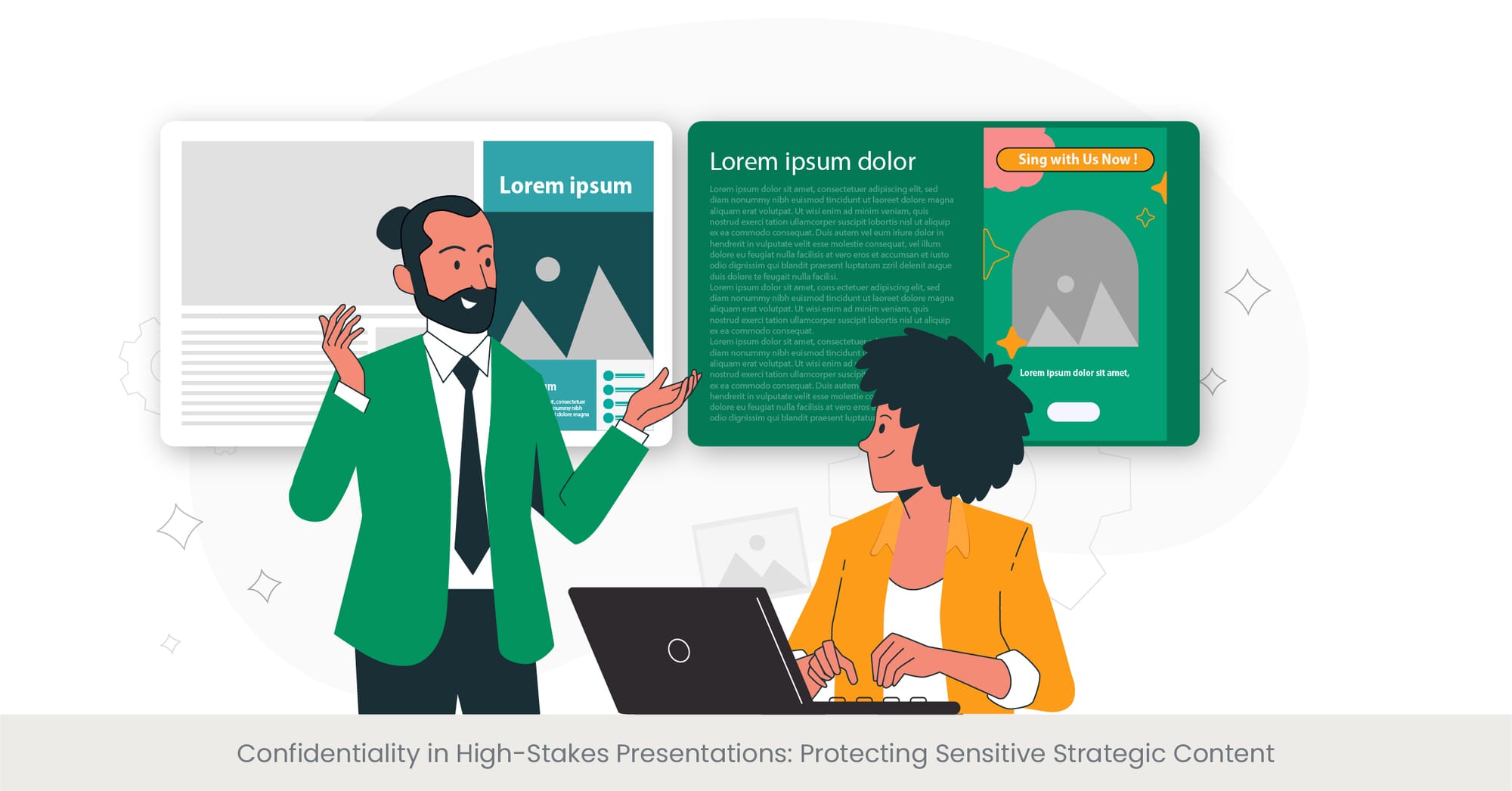
Differences from Typical Business Presentations: Focused on Influencing High-Stake Decisions and Strategic Directions
Influencing the Course of Business: A Strategic Imperative
When it comes to high-stake business decisions, the stakes couldn't be higher, and the audience couldn't be more critical. Unlike typical business presentations, which often focus on sharing information or reporting on progress, presentations aimed at influencing strategic directions are designed to sway senior decision-makers and set the course of a true leader and future actions. These presentations go beyond the mere dissemination of data; they are crafted to make a compelling case for specific strategic moves, considering the broader impacts on the organization's future.
The Roots of Strategic Presentations with different leadership styles
Understanding the significance of these presentations requires a dive into their foundational aspects. Traditionally, business presentations might detail operational updates or departmental achievements. However, when the goal shifts towards influencing strategic directions, the presentation must pivot towards a more visionary approach. This involves not only a thorough understanding of the current business landscape but also an adeptness in forecasting and scenario planning, skills that are cultivated over years of experience with different leadership styles and deep industry knowledge.
Real-World Applications and Notable Examples
Take, for instance, a tech company that is deciding whether to invest in a new market segment. A strategic presentation to the executive board might utilize sophisticated market analysis, competitor assessments, and financial projections to argue for the investment. This approach is not just about presenting data but about crafting a narrative that aligns the proposed strategy with the company’s long-term goals, such as market leadership or diversification. Recent trends show that the use of dynamic data visualization tools and the integration of predictive analytics into these presentations can significantly enhance their persuasive power.
Validating Through External Insights
Recent studies and expert opinions underscore the effectiveness of strategically focused presentations in influencing senior executives. For instance, a Harvard Business Review article highlighted that presentations which strategically align with company goals and demonstrate clear, actionable paths forward are more likely to receive executive buy-in. Furthermore, industry-specific data show that companies that excel in strategic presentations are 30% more likely to achieve competitive advantages in their markets. These statistics not only validate the approach but also emphasize the need for meticulous preparation and customization in such presentations.
Tailoring to Senior Executive Audiences: Meeting High Expectations

Precision and Perceptiveness in Executive Communications
Presentations for senior executives are not standard fare; they require a nuanced understanding of what drives the decision-making processes at the highest levels of an organization. These audiences have little time and less patience for fluff—they demand clarity, conciseness, and most importantly, relevance. Tailoring a presentation for this group means focusing sharply on strategic insights and implications, ensuring that every slide and every word supports the overarching decision that needs to be made.
Background: Crafting for the C-Suite
The evolution of executive presentations can be traced back to the increasing complexities of global business environments. As businesses expand and the stakes of decisions rise, the need for highly strategic, impactful communications has become paramount. This involves an in-depth understanding of the business's core objectives and the strategic mindset of its leaders. Presenters must be adept at speaking the language of the C-suite, which often revolves around risk assessment, strategic advantage, and long-term profitability.
Illustrating Through Case Studies
A prime example of an effectively tailored presentation might involve a scenario where a multinational corporation considers a significant merger. The presenter would need to construct the presentation to not only outline the financial benefits and risks but also to address potential regulatory concerns and cultural integrations—topics of critical interest to the executive audience. For instance, Apple's acquisition of Beats by Dre in 2014 was backed by presentations that highlighted not just economic gains but strategic enhancements to Apple’s music streaming service.
Empirical Support and Statistical Relevance
Research indicates that presentations tailored to executive needs are more likely to succeed. A study from McKinsey noted that when presentations are directly aligned with the strategic priorities understood and shared by the executive team, the likelihood of positive reception increases significantly. Furthermore, data from a survey conducted by Forbes suggest that presentations which concisely link strategic decisions to long-term shareholder value see a 50% higher approval rate on proposed initiatives.
Emphasizing leadership presentation ideas, Qualities, Vision, and Forward-Thinking

Showcasing Visionary Leadership Through Strategic Presentations
Presentations that effectively emphasize leadership qualities and forward-thinking are pivotal in high-stake environments. These are not just about sharing information; they're about showcasing a leader's vision for the future of the organization and their ability to guide the company towards that future. This type of leadership presentation ideas elevates the discourse from operational to visionary, helping to paint a picture of what could be achieved under guided leadership.
Understanding the Impact of Visionary Leadership
The ability to project vision and forward-thinking in a presentation has its roots in the very essence of leadership. Historical examples, such as Steve Jobs at Apple or Satya Nadella at Microsoft, demonstrate how visionary leadership has been crucial in steering companies towards new heights and directions. These great leaders used their strategic presentations not just to inform but to inspire, coupling their understanding of the market with a clear vision for the future.
Real-World Applications and Notable Examples
Consider the impact of Elon Musk’s presentations on SpaceX and Tesla’s direction. Musk’s ability to convey his vision of colonizing Mars or a world powered by sustainable energy has not only shaped his companies’ strategies but also mobilized significant resources and public support. His presentations are laced with leadership qualities, using stories of challenges overcome and milestones achieved to inspire confidence and commitment from stakeholders and the wider audience.
Validating Visionary Leadership Through Data
Supporting the effectiveness of visionary presentations, a 2021 survey by Gartner revealed that organizations led by visionary leaders are 45% more likely to experience above-average growth. Furthermore, according to a Deloitte study, companies with good leaders that effectively communicate their vision through high-level presentations see a 30% higher employee engagement rate, underscoring the importance of leadership in strategic communications.
Confidentiality in High-Stakes Presentations: Protecting Sensitive Strategic Content

The Imperative of Secrecy in Strategic Decision-Making
In the realm of high-stakes business decisions, the protection of sensitive information is paramount. Presentations that deal with strategic directions often contain confidential data that could significantly impact the company if leaked. Thus, crafting these presentations requires not only a deep understanding of the content but also an unwavering commitment to its confidentiality. This ensures that the strategic insights shared are preserved for the eyes and ears of only those directly involved in the decision-making process.
Background on the Necessity of Confidentiality
The requirement for confidentiality in business presentations has grown with the increased pace of global information exchange. In a world where competitive advantages can be eroded by the premature release of strategic plans, protecting this information becomes as crucial as the strategies themselves. Historical instances, such as product launches in the tech industry or merger discussions in finance, illustrate the catastrophic consequences of breaches in confidentiality.
Illustrating Confidentiality Through Examples
An example of the importance of confidentiality can be seen in the merger talks between two leading pharmaceutical companies, which were kept under wraps until the strategic objectives were finalized. The presentation used in their executive meetings was developed with strict access controls, ensuring that only key stakeholders were privy to the details. This level of secrecy prevented market speculation and competitive countermeasures, allowing for a smoother negotiation and integration process.
Empirical Evidence Supporting the Need for Confidentiality
According to a study by PwC, companies that maintain rigorous confidentiality protocols for their strategic presentations are 33% less likely to encounter data breaches compared to those that do not practice them. Moreover, a survey conducted by the Harvard Business School found that executives and managers who ensured the confidentiality of strategic presentations were able to secure stakeholder trust more effectively, directly contributing to a 20% increase in successful strategic implementation.
Leveraging Persuasive and Motivational Speaking Techniques

Mastering the Art of Persuasion in Leadership Presentations
When it comes to high-stakes presentations aimed at senior executives, the ability to persuade and motivate becomes a key performance differentiator. Unlike typical business presentations that might focus primarily on delivering data, these strategic presentations use persuasive speaking techniques to sway decision-makers towards a proposed course of action. This requires not only a strong command of the subject matter but also an understanding of the psychological dynamics of persuasion and motivation.
Background: The Science of Persuasion
The roots of persuasive speaking can be traced back to ancient rhetoric, but its application in modern business contexts has evolved dramatically. Today, effective persuasion in leadership presentations involves a mix of ethos, pathos, and logos—establishing credibility, appealing to emotions, and using logical arguments. Understanding how these elements can be woven into business communications is essential for influencing high-level decision-making.
Real-World Applications and Notable Examples
One notable example of effective persuasive speaking in a corporate setting is a CEO’s presentation to potential investors. The CEO might use compelling narratives about the company’s future, supported by robust data analytics, to create a sense of urgency and potential for growth. Additionally, motivational elements such as stories of employee dedication and innovation can be employed to forge an emotional connection, encouraging investors to act.
Empirical Support for Persuasive Techniques
Studies underline the effectiveness of persuasive speaking in executive settings. A report by Forbes indicates that executives who employ persuasive techniques in their presentations are 50% more likely to secure approval for strategic initiatives. Furthermore, a neurological study published in the "Journal of Neuroscience" found that emotionally charged presentations activate certain brain regions more intensely, enhancing the retention of the presented information and increasing the likelihood of favorable decisions.
Prioritizing Impactful Storytelling to Drive Leadership Training Topics

The Power of Narrative in Executive Decision-Making
In the context of high-stakes presentations, storytelling isn't just a tool—it's a strategic asset. Effective leaders understand that to drive their agendas and teams forward, they need to do more than present facts and figures; they must weave these elements into a compelling narrative that captures the imagination and commitment of their audience. This approach to storytelling prioritizes the emotional and motivational aspects of communication, making it an indispensable technique in leadership presentations.
Background: The Role of Storytelling in Leadership
Historically, storytelling has been a cornerstone of leadership training, used to inspire troops, drive change, and instill values. In the modern corporate world, its role is no less significant. Strategic presentations often utilize storytelling to contextualize challenges, illustrate visions of the future, and highlight potential impacts on stakeholders. This method helps abstract strategic concepts become tangible and relatable, enhancing their persuasive power.
Illustrative Examples of Impactful Storytelling
Consider a CEO addressing an organization during a major strategic change management pivot, such as entering a new market or undergoing a digital transformation. By telling the story of the company's journey, the struggles faced, and the victories achieved, the CEO can frame the strategic shift in a way that resonates on a personal level with employees and stakeholders. For example, IBM’s transformation under Lou Gerstner in the 1990s was often communicated through narratives that highlighted a shift from hardware to software and services, rallying employees around a renewed vision of innovation.
Validating the Effectiveness of Storytelling
Research supports the effectiveness of storytelling in leadership presentations. A study published in the Harvard Business Review reveals that presentations incorporating stories can increase audience engagement by up to 70%. Additionally, psychological research suggests that stories are 22% more memorable than facts alone. These insights underscore the critical role of storytelling in ensuring that strategic messages not only reach but also impact executive audiences.
Leveraging Higher-Level Data Analytics to Support Arguments

Integrating Advanced Analytics in Strategic Decision-Making
In high-stakes leadership presentations, the integration of higher-level data analytics transcends traditional data reporting, evolving into a powerful tool to substantiate and enhance strategic arguments. This approach involves not just the presentation of data, but its strategic interpretation and linkage to broader organizational goals. Advanced analytics help paint a clearer picture of potential outcomes and scenarios, providing a robust foundation for strategic decisions.
Background: The Evolution of Data in Leadership
The use of data in business has seen a significant transformation over the years. Initially, data served merely as a means to report past performances. However, as analytics technology has advanced, so has the capacity for predictive and prescriptive analytics. In leadership presentations, the ability to forecast future trends and model potential strategies based on complex data sets is invaluable. It allows leaders to approach decision-making with a greater degree of confidence and precision.
Real-World Applications and Notable Examples
A pertinent example of utilizing high-level analytics in strategic presentations could be seen in a major retail company deciding on store expansions. By employing geospatial analytics and customer behavior data, the presentation would not only show current market penetration but also predict future growth areas and customer trends. Such data-driven insights are crucial in convincing senior executives of the viability and timing of expansion plans.
Empirical Support for the Use of Advanced Analytics
Research underscores the value of advanced analytics in executive decision-making. According to a study by Bain & Company, organizations that integrate high-level analytics into their strategic presentations are 23% more likely to outperform in profitability and efficiency. Moreover, a Deloitte survey found that executives who base their strategic decisions on advanced analytics have a 73% higher success rate in achieving their projected outcomes.
Adapting to Formal Settings and Sophisticated Visual Designs

Elevating Presentation Standards for Executive Audiences
High-stakes leadership presentations often take place in more formal settings, requiring a level of sophistication in both content and delivery that matches the expectations of senior executive audiences. The design of these presentations plays a crucial role, as it must not only convey professionalism but also facilitate the clear and effective communication of complex strategic insights. Sophisticated visual designs, therefore, become integral in enhancing comprehension and retaining the attention of high-level decision-makers.
Background: The Importance of Design in Executive Communications
The evolution of presentation design in business settings reflects a broader shift towards visual literacy as a key component of executive communication. In the past, presentations may have relied heavily on text and basic graphics. Today, however, the integration of advanced design principles and technologies allows presenters to create more engaging and persuasive visual narratives. This shift is particularly important in formal settings where the ability to convey information quickly and memorably can significantly impact decision-making processes.
Real-World Applications and Notable Examples
An excellent example of sophisticated visual design in action is seen in annual shareholder meetings of major corporations like Apple or Google. These presentations often utilize high-quality visuals, including interactive graphs, detailed infographics, and professionally produced videos, to communicate annual results, strategic directions, and future initiatives. Such elements not only capture and maintain the attention of busy executives but also help distill complex information into digestible and actionable insights.
Empirical Evidence Supporting Advanced Visual Designs
Studies indicate that well-designed visual presentations can increase information retention by up to 65%. Furthermore, a survey by the Professional Presentation Association found that executives are 85% more likely to make a favorable decision if the presentation is visually compelling. These findings emphasize the critical role sophisticated visual designs play in enhancing the effectiveness of strategic leadership presentations.
Delivering Long-term Visions Rather Than Immediate Operational Details

Focusing on the Horizon: Strategic Visions in Leadership Presentations
In the sphere of high-stakes leadership presentations, the focus is distinctly on shaping and sharing long-term visions rather than delving into granular operational details. This strategic approach is designed to align the executive team and stakeholders around a one idea and common future direction, setting the stage for transformative actions that will unfold over years, rather than immediate tactical maneuvers. The emphasis is on inspiring and mobilizing leaders to commit to a sustained, long-range plan that drives the company forward.
Background: The Shift from Operational to Visionary
The transition from operational to visionary content in presentations reflects a deeper understanding of the role senior executives play in an organization. These leaders are primarily concerned with steering the company towards future success, a job which requires a broad, forward-looking perspective. Operational details, while crucial at different management levels, are less pertinent in this context. Instead, the content needs to stimulate strategic thinking and long-term planning.
Illustrative Examples of Visionary Leadership
Consider the case of a tech company outlining its 10-year plan to lead in artificial intelligence. Instead of focusing on current AI product developments or sales metrics, the presentation emphasizes future industry trends, potential market disruptions, and the company's role in shaping the future of technology. This might include forward-looking statements and conceptual mock-ups of future products, which help paint a vivid picture of what's possible under the company's leadership.
Empirical Support for Long-Term Visionary Approaches
Research highlights the effectiveness of focusing on long-term visions in executive presentations. According to a study by the Strategic Management Society, companies whose leaders regularly communicate a clear, long-term vision are 40% more likely to experience sustained growth and resilience in volatile markets. Additionally, a Forbes survey found that executives who articulate a compelling future vision are 50% more likely to inspire high levels of commitment and loyalty from their teams.
Building Towards Significant Calls to Action That Prompt Executive Action

The Culmination of Strategic Presentations: Driving Decisive Action
In high-stakes leadership presentations, the ultimate goal is to build towards creating a compelling call to action (CTA) that prompts executive decision-makers to take concrete steps. This effort isn't just about concluding with a strong finish; it's about crafting every element of the presentation to lead naturally to a decisive and actionable conclusion. The CTA is designed to be the natural response to the information and narratives presented, encapsulating the urgency and necessity of the proposed actions in light of strategic objectives.
Background: The Art of the Call to Action in Leadership
Historically, the most effective meetings impactful presentations have not just informed or inspired; they have moved audiences to action. This is particularly critical in business environments where decisions can have far-reaching implications for the company's direction and success. In crafting a CTA, it's essential to tie back to the core themes, ideas and strategic goals discussed, making the action step feel like a necessary and urgent progression.
Real-World Applications and Notable Examples
An illustrative example is seen in corporate restructuring scenarios where a CEO might need to convince the board to approve a controversial strategy. The presentation would methodically address the challenges and opportunities, supported by data and narratives, leading to a CTA that proposes specific steps for implementation, such as divestiture of non-core assets or acquisition of strategic technologies. These presentations are structured to ensure that by the end, the logical and emotional paths lead the audience to agree on the necessity of the proposed actions.
Empirical Evidence Supporting Effective CTAs
Studies underline the effectiveness of well-constructed CTAs in leadership presentations. According to research published in the Journal of Business Communication, presentations that conclude with a clear, specific CTA see a 70% higher conversion rate in terms of decision-making than those that do not. Furthermore, a survey by the International Association of Business Communicators found that executives are 60% more likely to prioritize projects that are presented with a compelling CTA, indicating the power of strategic closure in presentations.
Frequently Asked Questions
What are the 5 P's of effective leadership?
The 5 P's of effective leadership are Purpose, Passion, Perseverance, People, and Performance. Each element of leadership styles plays a different ways critical role in shaping a leader's ability to guide their team and organization towards success. By focusing on these pillars, leaders can develop a comprehensive approach that enhances their influence and effectiveness.
How to do a leadership presentation?
To deliver an effective leadership presentation, start by clearly defining your objectives and understanding your audience's expectations. Structure your content to include a compelling mix of data, insights, and personal stories. Use sophisticated visual aids to reinforce your message, and conclude with a strong call to action that ties back to your team and strategic goals.
What are the objectives of a Leadership Skills presentation?
The primary objectives of a leadership presentation are to inform, inspire, and motivate strategic action. These presentations are tailored to show leadership skills, influence high-stake decisions and guide organizational direction, often involving detailed discussions on future visions and various leadership roles and agendas.
What are the qualities of a good leader?
A good leader exhibits qualities such as integrity, accountability, empathy, resilience, and foresight. These attributes are essential for inspiring trust, fostering teamwork and diversity, and driving effective decision-making within an organization.
What differentiates a leadership presentation from a standard business presentation?
Unlike standard presentations that often focus on operational details and immediate tasks, leadership presentations are designed to influence strategic decisions, showcase long-term visions, and address the needs of senior executive audiences.
How can leaders use presentations to influence organizational change?
Leaders can use presentations to drive organizational change by effectively communicating the need for change, the benefits of the proposed changes, and the steps required to achieve these changes. Using persuasive techniques and impactful storytelling, teams can greatly enhance this process.
What role does data play in a leadership presentation?
Data plays a crucial role in leadership presentations by providing a factual basis for strategic arguments and decisions. High-level analytics are used to support claims, predict outcomes, and persuade senior executives of the viability of proposed strategies.
How important is visual design in leadership presentations?
Visual design is extremely important in leadership training and presentations as it enhances comprehension, engages the audience, and helps convey complex information succinctly. Sophisticated visual aids can significantly influence the effectiveness of the presentation.
Can leadership presentations impact company culture?
Yes, leadership presentations can have a profound impact on company culture by shaping perceptions, setting standards, and modeling behaviors expected from team members. They are an essential tool for leaders to articulate and disseminate organizational values and goals.
What are the challenges of preparing a high-stakes leadership presentation?
Preparing a high-stakes leadership presentation involves challenges such as ensuring accuracy and confidentiality of strategic content, crafting a message that resonates with senior executives, and aligning the presentation with the long-term goals of managing the organization.



%20(1).jpg)
%20(1).jpg)


